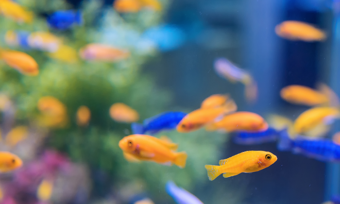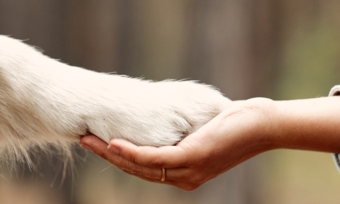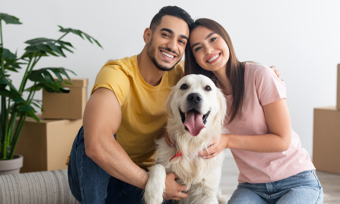
Basic cues for puppy training
At seven to eight weeks old, your puppy is ready to begin learning basic cues like ‘sit’, ‘stay’ and ‘come’. They’re full of lots of energy and noise but have a short attention span. So, keep sessions short. Five sessions a day of five to 10 minutes each is plenty.
Reward your puppy with bite-size treats to signal they’re doing the right action (more on the best puppy training treats below). Treats at the ready, here’s how to begin.
Sit
Hold a treat near your pooch’s nose to get their attention. Raise the treat higher while commanding “sit”. As he or she lifts their head toward the treat, they’ll automatically drop their bottom to the ground. If this doesn’t work, repeat the sequence. Only give the treat once they sit.
Stay
Once your pup has mastered the “sit” cue, tell them to sit and take one or two steps back. Calmly say “stay” while holding up your hand in a stop position. If they stay for at least a few seconds, they deserve a reward. Continue to practise this cue while increasing the distance, duration and number of distractions over time.
Come
Use your treat to lead the puppy a few steps toward you while saying “come”. You can reward them and keep practising while gradually increasing the distance they must cover to get to you.
These foundational skills will help protect your puppy at home (and your visitors, family, and furnishings), as well as once you begin taking them on outings.
How to toilet train a puppy
You should begin potty training a puppy as soon as they come home, regardless of age.
How do you go about potty training your puppy? Designate a ‘where to go space’ as well as a safe zone for when you can’t watch them.
- Designated space: designated potty area helps with puppy training (and smells)! Take pup to this spot at the intervals listed further down. Once he or she goes in the right spot then reward them with praise or a treat immediately. Reinforcing the right actions is a key element to successful puppy toilet training.
- Safe zone: puppy proof your safe zone – keeping it free of cables, chemicals and non-puppy-friendly furniture. Lay down some puppy training pads away from their water bowl, as dogs don’t like to go near their food/drink.
When puppy needs to go
Puppies need to go regularly as they have small bladders, so keep to a consistent schedule. Take pooch outside every two hours. If he or she has an accident at 30 minutes then reduce intervals to 30 minutes. You can gradually increase the amount of time to one and then two hours from there.
Take your puppy outdoors at the following intervals:
- First thing in the morning
- After meals
- After naps
- Before leaving them on their own at home
- Last thing at night
Never punish your puppy for mistakes
Toileting in the wrong place? Don’t punish; they won’t know what the punishment means and might also become fearful. If you do happen to catch your fur baby in the act, clap loudly, then lead them to the correct spot.
Remember to reward straight after puppy uses the correct toileting spot to reinforce good behaviour. When it comes to positive reinforcement dog training the proof is in the pudding – it works!
In addition, follow these tips:
- Communication is key: all kinds of communication from pooch could mean they need to go. Take him/her outside if they start whining, scratching at the door, circling, squatting, or showing any signs of restlessness.
- Keep it clean: be sure to clean up any accidents with a detergent that removes smells. Otherwise, your pet will keep coming back to the same spot to make new messes.
If you live in an apartment or don’t have garden access then there are a range of options from puppy pads to artificial grass. If your pup does have access to a garden, then you may still want to demarcate an area. Unless the whole garden is the area – the choice is yours.
How to create train a puppy
Having a den is important to your pet’s sense of well-being. A crate provides a secure hidey hole and promotes happy sleeping and resting time. And if you keep it up it also means they have somewhere other than your bed to lay their weary head.
Not everyone and their pups like crates, so it’s not for you, consider other options, like a playpen or safe zone. If you decide to go ahead, then you can begin crate training from as young as eight weeks old.
Some things to remember when create training
- Never leave puppy inside the crate for too long – you don’t want them to soil their bed as this can create a negative pattern.
- Let your pup out at one-hour intervals during crate training and give them time to play (as playtime is essential for dogs) before returning to the crate. If you’re crate training your puppy at night, intervals can be three hours long.
- The crate is a safe space – don’t use it to punish your puppy. If your puppy gets separation anxiety, it might be better to bring them back out. Separation anxiety in pets can cause potty accidents, which will lead to setbacks in training.
- Play games to reinforce the crate as a positive space. You can throw the ball into the crate or put a treat inside so puppy gets the hang of going in and out on their own.
- Remove the collar and tag when your puppy is in the crate. These are a strangling hazard if they get hooked on the crate.
- When your puppy is active and playful, keep them out of the crate. Only put them in the crate once they’re calm. This reinforces the link between the crate and the den.
To help you decide what size crate to buy research how big your puppy will grow. A fully grown dog must be able to stand up and turn around inside their crate.
How to leash train your puppy
As with crate training, start teaching your puppy to go on a lead at eight weeks old.
Get them used to wearing the collar and lead around the house first. This puppy training must be supervised as the lead can be dangerous if it hooks onto furniture. Once puppy is used to the collar, take them around the house and garden on-lead. Try to keep some slack on it. If your pooch starts to pull, stop walking. Try out your basic commands throughout the session, so they get used to listening to you during a walk. Place treats along a specific route you want your pup to take.
How to train a timid puppy
Shy puppies require a gentle approach to training in order to build their confidence. Try the following tips when training your timid pet:
- Use treats as motivation and rewards during training sessions
- Begin with baby steps and gradually introduce your pup to new experiences, people, and places
- Shower your puppy with praise, cuddles (treats) and belly rubs whenever they show signs of confidence or conquer a fear
- Patience is the key to success. Avoid overwhelming them with too much too soon. Take it slow and be understanding
- Engage your timid puppy in interactive play sessions that build their confidence while burning off some puppy energy. Fetch, hide-and-seek and creating your own backyard agility course are all fantastic ways to boost their self-assurance
What are the best treats for puppies?
Here are a few of the best creative and healthy puppy training treats to make using fruits and vegetables:
- Banana bites: slice a ripe banana into small, bite-sized pieces. Bananas are a great source of potassium and a tasty reward for pup during training sessions.
- Sweet potato chews: cut sweet potatoes into long, thin strips and bake them until chewy. Sweet potatoes are packed with vitamins and make a delicious, natural chew toy.
- Carrot crunchies: slice carrots into thin rounds or sticks and lightly steam until tender. They’re a low-calorie treat that can help with your pup’s dental health – a win-win when it comes to deciding on the best puppy training treats.
- Apple slices: core an apple and cut into thin slices. Apples are a good source of fibre and a refreshing, crunchy reward for pup.
- Watermelon popsicles: Puree seedless watermelon and pour the mixture into ice cube trays. Freeze them until solid, and voila! You’ve got a hydrating treat for balmy summer days.
- Blueberry bonanza: Give your pup a handful of fresh blueberries as a puppy training treat. Blueberries are packed with antioxidants and make for a sweet and healthy reward.
When introducing some of the best puppy training treats to your pup during a puppy training session, observe their reaction and ensure they don’t have any adverse effects or allergies.

Do I need to vaccinate my puppy?
In addition to essential puppy training life skills like crate training, now is also an important time to do pet vaccinations. Once you head into the wide world, your puppy will be exposed to all sorts of new bacteria, contaminants and things that can poison them.
Vaccinate according to your vet’s recommended schedule to make sure any trips to the park and beyond don’t spell possible danger.
Once you start going for neighbourhood and park walks you’ll also need to consider other people and their dogs. Be aware that dog fights (and dog bites) can happen – even between well-behaved dogs for a number of reasons. If your dog is injured or injures another dog or its owner, it’s best to be insured.
Compare pet insurance providers here!
About the reviewer of this page
This report was reviewed by Canstar Content Producer, Caitlin Bingham. Caitlin is an experienced writer whose passion for creativity led her to study communication and journalism. She began her career freelancing as a content writer, before joining the Canstar team.
Enjoy reading this article?
You can like us on Facebook and get social, or sign up to receive more news like this straight to your inbox.
By subscribing you agree to the Canstar Privacy Policy







Share this article